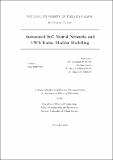Automated SoC neural networks and UWB radar bladder modelling

View/
Date
2016-11-10Author
Krewer, Finn
Metadata
Show full item recordUsage
This item's downloads: 1066 (view details)
Abstract
This thesis describes two significant research achievements. Part I describes the development of a novel System on Chip (SoC) hardware neural network simulator for diverse and biologically accurate neural network simulations. This work seeks to contribute to research in neuroscience which requires large and fast simulations of biological nervous systems. The presented embedded FPGA neural network simulator utilizes time-multiplexed hardware neuron models to simulate thousands of complex biological neurons on embedded hardware. A high level synthesis method has been developed to automatically convert high level neuron and synapse models to synthesizable VHDL hardware models and automatically implement and test the models on FPGA hardware. The accuracy of the converted models has been validated by comparison to reference software simulations. The state of the art in neural network simulations is presented. A new FPGA-based neural network simulation platform has been designed, implemented and verified. The high level synthesis method has also been implemented as part of the Si elegans platform which aims to simulate the nervous system of the Caenorhabditis elegans organism in FPGA hardware.
Part II of this thesis examines the use of Ultra Wideband Radar as a bladder-state sensing technique for the potential application in urinary incontinence support. The research has explored and developed efficient and practical methods to simulate radar signal propagation in biological tissues. A genetic algorithm has been developed to fit arbitrary tissue dielectric Debye models. This algorithm has been applied to all relevant tissues in the human pelvis, and has been used to provide a database of Debye tissue dielectric models for a large selection of human tissues. The thesis combines the tissue dielectric Debye models with anatomically accurate models of the human pelvis (one male and one female), derived from IT'IS Foundation Magnetic Resonance images. Electromagnetic simulations of UWB-radar passing through an anatomically-plausible bladder growth model have been performed, to acquire simulated bladder volume measurements. Two standard classifiers have been applied to the simulated UWB measurements. This work concludes that with sufficiently high quality UWB measurement devices and minimal device movement classification of bladder volume using UWB radar is possible.

